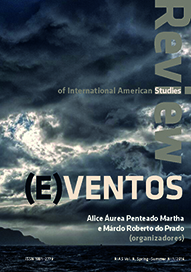

[For English, scroll to the bottom of the page]
Ricardo Portella de Aguiar
Universidade Federal Fluminense
Niteroi, Brasil
"PEREGRINAÇÕES TRANSCIBERNÉTICAS"
O modelo de comunicação adotado nos dias de hoje difere radicalmente do praticado nos séculos passados. Atualmente, a necessidade de interação social tem sido suprida pelo uso e abuso de um espaço disponível a todos que conseguem uma forma de acessar um computador ligado à Grande Rede. Este espaço é composto por inúmeros Territórios Virtuais — Ciberterritórios — povoados por diversas Comunidades igualmente Virtuais dispersas geograficamente, mas interligadas por um poderoso sistema de comunicações, formando o Mundo Virtual. Nesse mundo — viabilizado pela Tecnologia da Informação, pelas redes de telecomunicações e pelos computadores — são praticadas inúmeras formas de linguagem, nos mais bizarros agrupamentos de pessoas sem identificação ou localização precisa, tendo como pano de fundo uma nova forma de escrita inaugurada na era da cibernética — o Texto Digital. Esse Mundo Virtual — emaranhado binário construído sobre artefatos cibernéticos — abriga boa parte do conhecimento e é objeto de desejo do homem contemporâneo: um espaço fruto da imaginação humana, tornado possível através da rigidez de protocolos e da flexibilidade das linguagens da máquina. Um labirinto no qual o tesouro é a entrada para outros incontáveis labirintos. Às peregrinações transatlânticas e transpacíficas se juntou a peregrinação virtual. Através dos infinitos oceanos voamos e nos perdemos; vagamos desnorteados pelos caminhos vertiginosos mantidos pela Linguagem e pela Tecnologia. Diante de cada um dos territórios possíveis na vastidão do Mundo Virtual, perplexos e indecisos por tantas escolhas possíveis, nos fazemos passivos diante da imensidão dos oceanos binários. Esta comunicação é sobre a peregrinação por territórios onde não há limites e não se reconhece o sujeito, porque tudo, lá, é metamorfose.
Palavras-chave: Internet; Virtual; Cibercultura
"Transcybernetic Pilgrimages"
The communicational model adopted today is radically different from that practiced in the past centuries. The essential human need for social interaction has been transformed by the use and abuse of the space available to all those who have access to a computer linked to the ‘Big Net’. This space, composed of many Virtual Territories, or Cyberterritories, has been called into existence by diverse, and equally virtual, Communities. Geographically disperse, but interlinked within a powerful system of communications, they all make up the Virtual World. In this world—owing to the development of Information Technology that gave birth to telecommunication networks that connect countless individual devices—multiple forms of language develop among the most astounding groupings of people, often without precise identification or precise location, against the backdrop of a new form of writing inaugurated at the onset of the Cybernetic Era—the Digital Text. The Virtual World—a binary tangle built on cyber artifacts—is home to much knowledge and, at the same time, an object of desire of modern man: simultaneously a figment of human imagination and a space made possible by both the rigidity of protocols and the flexibility of machine languages. A maze hiding a treasure which, in itself, is a portal leading us into other, countless, labyrinths. With the birth of the Virtual World, the familiar, albeit uncanny, experiences of the trans-Atlantic and trans-Pacific peregrinations have become complemented by the experience of the virtual peregrination. We sail the infinite seas—and therein we become lost; bewildered wanderers, we follow vertiginous trails of Language and Technology. Enchroaching upon each of these possible territories within the vast space of the Virtual World, hesitant, perplexed by the plethora of possible choices, we become passive in the face of the immensity of the binary seas. This article addresses the issue of the peregrinations in the boundless territories recognizing no limitations and no subjectivity: territories in which everything that exists—is a metamorphosis.
Keywords: the Internet; Virtual Space; cyberculture
Download files
Citation rules

Vol. 9 No. 1 (2016)
Published: 2016-06-29
 10.31261/RIAS
10.31261/RIAS